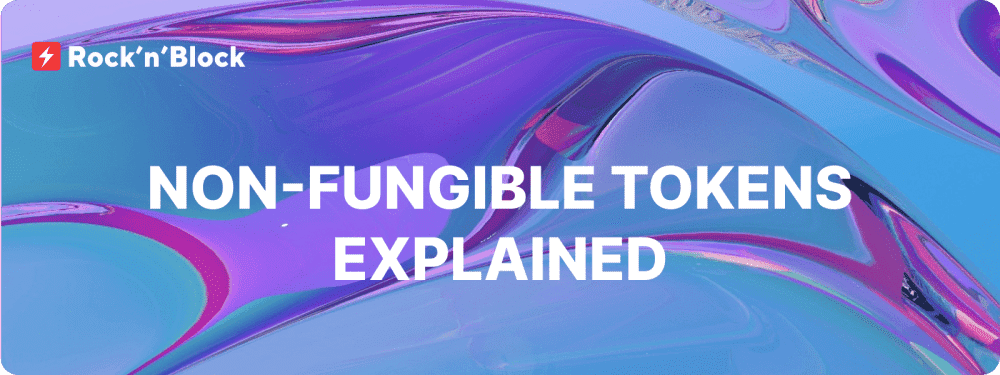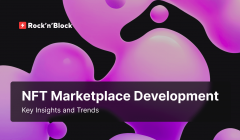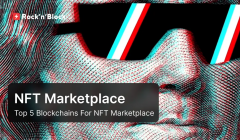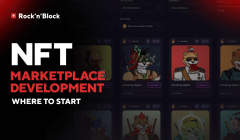10 Core Features for NFT Marketplace Development
03 May 2024Non-Fungible Tokens (NFTs) have caused a sensation worldwide, as they have transformed the concept of ownership and digital assets. NFT marketplaces are the entry point to this exciting arena, where creators, artists, and collectors come together to exchange, produce, and invest in exclusive digital tokens. Let's dive into the primary characteristics that are fundamental in the NFT marketplaces development, illuminating how these aspects stimulate progress, safety, and user participation. Whether you are an experienced developer or a beginner interested in entering the world of NFTs, it is essential that you grasp the crucial aspects required for success and making an impact in the digital ownership revolution.

Table of Contents:
-
What Are NFTs and Why Have They Gained Such Widespread Popularity?
-
How Does an NFT Marketplace Work?
-
Key Features for NFT Marketplace Development
-
Top NFT Marketplaces of 2023
-
The Future of NFTs
-
Conclusion
What Are NFTs?
In the era of digital innovation, NFTs have become one of the most intriguing and revolutionary trends. In essence, NFTs are digital tokens representing the ownership of singular and unique items, whether they are digital art, music, virtual real estate, or even tweets. Unlike fungible and interchangeable cryptocurrencies like Bitcoin and Ethereum, Non-Fungible Tokens are distinct and irreplaceable. Each NFT has a unique identity, which is authenticated and recorded on a decentralized and tamper-proof digital ledger called a blockchain. This uniqueness is the sole reason behind the inherent value of NFTs.
 More Than Digital Art and Collectibles
More Than Digital Art and Collectibles
NFTs extend beyond mere collectibles by representing ownership and authenticity not only for digital content but also for a wide array of tangible and intangible assets. In the realm of NFT marketplace development, these unique tokens facilitate the tokenization of real-world assets such as real estate tokenization, intellectual property, and even fractionalized ownership of physical goods, showcasing the transformative potential of blockchain technology in reshaping traditional notions of value and ownership across diverse industries.
-
Digital Ownership and Scarcity
NFTs now enable true ownership and trading of digital assets, which were previously easily copied and shared, thereby reducing their value. NFTs create scarcity and ownership rights for digital items, thus enabling creators to sell their work and allowing collectors to possess unique and verifiable assets.
-
Blockchain Technology
The reliability and security of blockchain technology development are crucial to the triumph of NFTs. It assures the origin of digital items, hindering the production of fake or unauthorized replicas. The transparency of blockchain also reinforces trust within the NFT community.
-
Celebrity and Artist Endorsement
Prominent and influential figures from the worlds of entertainment, music, and art have propelled NFTs into the public eye. The engagement of well-known personalities such as Elon Musk, Beeple, and Kings of Leon has generated significant interest from their substantial fan bases.
-
Digital Art and Creative Expression
The impact of NFTs on the art world has been significant. They allow artists to connect directly with global audiences, circumventing traditional gatekeepers. Additionally, the ability to earn royalties on secondary sales is a game-changer for creators.
-
Virtual Real Estate and Gaming
NFTs have entered the realm of virtual worlds and gaming. With NFTs, players are now able to purchase, sell, and trade in-game assets, while virtual property has turned into a highly coveted commodity.
-
Collectibles and Fandom
NFTs have spawned the digital version of trading cards and collectibles. Fans can purchase and trade unique, often nostalgic items, fuelled by their passion and desire to own a piece of digital history.
-
Financial Speculation
The potential for significant returns has drawn speculators to invest. Certain NFTs have fetched mind-boggling sums, generating publicity and intensifying fascination in the field.
How Does an NFT Marketplace Work?
An NFT marketplace is a digital platform where individuals can explore, purchase, sell, and exchange non-fungible tokens. It combines elements of a digital auction house, art gallery, and stock exchange, tailored specifically for these unique digital assets. Such marketplaces offer a safe and intuitive arena for creators, collectors, and enthusiasts to interact with one-of-a-kind digital assets.
NFT marketplaces operate on blockchain technology, which guarantees transparency, security, and provenance.
The NFT marketplace development has several key purposes
1. Tokenization of Digital Assets: NFT marketplaces enable creators to tokenize their work, establishing provenance and ownership on the blockchain.
2. Monetization for Creators: Artists, musicians, and content creators can monetize their digital creations by selling them as NFTs on these platforms. NFTs offer a clear path for creators to earn royalties on subsequent sales, guaranteeing sustained revenue.
3. Marketplace for Collectors: NFT marketplaces create a space for collectors to discover, purchase, and trade digital assets. By building portfolios of unique and rare digital items, collectors contribute to the expansion of digital art and collectibles markets.
4. Smart Contracts and Transparency: Blockchain technology and smart contracts form the base of NFT marketplaces, ensuring trustworthiness, safety, and genuineness. The employment of blockchain verifies ownership and transaction history, thus decreasing the possibility of swindle and imitation.
5. Decentralization: Many NFT marketplaces operate on decentralized blockchain networks, reducing reliance on centralized intermediaries. This aligns with the ethos of decentralization and blockchain principles.
6. Global Accessibility: NFT marketplaces offer a worldwide platform for artists and collectors, removing geographical barriers. The NFT ecosystem is accessible to anyone with an internet connection, providing a more diverse and inclusive marketplace.
7. Innovation and Experimentation: The NFT marketplace development encourages innovation and experimentation in the digital space. Artists and developers explore fresh approaches to leverage blockchain technology for creative expression and diverse business models.
In summary, NFT marketplaces are developed to provide a platform for buying, selling, and trading non-fungible tokens. These marketplaces serve as a centralized hub that facilitates the creation, discovery, and exchange of unique digital assets on the blockchain.
The guide below outlines how they operate and explores the key features of NFT marketplace development.
10 Core Features for NFT Marketplace Development
Whether you are a beginner interested in entering the world of NFTs or contemplating building your own NFT marketplace, below are the key ten features to evaluate.
Be sure to check out our detailed step-by-step guide: NFT Marketplace Development from Scratch.

1. User-Friendly Interface
Intuitive navigation, lucid instructions, and an attractive design will make the platform more accessible and enjoyable for users. It not only enhances the user experience but also plays a critical role in enticing and retaining users. A user-friendly interface simplifies the process of creating, purchasing, and selling NFTs, making it accessible even to those with limited technical knowledge.
Furthermore, an intuitive interface promotes trust and transparency, indispensable elements in a field where authenticity and provenance are vital.
2. Cross-Chain Support
Different blockchain networks have a range of features, capabilities, and user bases. NFT marketplaces that implement cross-chain integrations enable NFTs to move seamlessly across multiple blockchains, providing a larger and more diverse marketplace for digital assets. This not only gives users more options but also allows for greater interoperability, enabling NFTs to interact with various decentralized applications and services.
Additionally, cross-chain support enhances the scalability of NFT marketplaces, as it enables the platform to adapt and grow with evolving blockchain technologies and user preferences.
3. Supporting multiple payment options
These methods are the financial backbone of the ecosystem, providing a means for creators, collectors, and the platform itself to transact and generate revenue. The platforms improve accessibility and inclusivity by offering multiple payment methods, including cryptocurrencies, credit cards, and other traditional forms of payment.
This ensures that the NFT marketplace caters to a diverse global audience of users from different backgrounds and regions. Moreover, it broadens the user base and boosts the liquidity of the marketplace, which is crucial for the trading and exchange of NFTs.
4. Minting Tools
Minting tools are crucial for artists and content creators, as they enable users to easily create NFTs by uploading their digital content, setting properties such as royalties, and defining ownership rights.
These tools simplify the complex minting process by offering user-friendly interfaces and easy-to-follow procedures. These tools also aid in the standardization of the minting process, guaranteeing that each NFT adheres to the platform's guidelines and the blockchain's standards.
5. Discovery: Browsing, Storing, and Search
A search tool for NFT marketplace enables users to effortlessly browse and discover NFTs. It allows users to explore, locate, and engage with a wide variety of digital assets, including art, collectibles, virtual real estate, and more. Organize NFTs by type, artist, collection, or popularity to enhance the marketplace's organization and user-friendliness.
Moreover, the system's powerful discovery tools showcase up-and-coming artists and popular digital assets, promoting an active ecosystem and helping creators gain recognition.
6. Licensing and Copyright Management
Licensing and copyright management comprise fundamental components of NFT marketplace establishment, particularly in the sphere of digital art and creative possessions.
To protect the rights of creators and collectors, implement licensing and copyright management features. This guarantees the automatic distribution of royalties and the upholding of intellectual property rights.
7. Security and Compliance
The integrity of the blockchain, as well as users' trust, must be protected at all costs. The implementation of rigorous security measures is crucial to detect and mitigate potential threats or vulnerabilities.
Furthermore, NFT marketplaces must deal with the changing regulatory environment and tackle matters such as safeguarding intellectual property rights, adhering to tax requirements, and complying with anti-money laundering (AML) and know-your-customer (KYC) obligations in accordance with the law in each jurisdiction.
By prioritizing security and compliance, NFT marketplaces can establish trust with their clientele, cultivate a secure atmosphere for trading digital assets, and position themselves as trustworthy platforms in the digital ownership revolution.
8. Customizable Smart Contracts
Customizable smart contracts play a key role in the development of NFT marketplaces, enabling flexibility and adaptability within the ecosystem. These contracts serve as the digital backbone of NFTs, and the capacity to customize them to meet specific needs is invaluable.
NFT marketplace developers have the opportunity to design smart contracts that delineate the platform's exclusive rules, royalties, and functionalities. This customization guarantees that each NFT conforms to the marketplace's standards, transaction fees, and secondary sales royalties, providing users with a seamless and standardized experience.
9. Community and Social Features
-
User profiles, messages, interactive forums, etc: These features create a dynamic and engaging environment, allowing creators, collectors, and enthusiasts to connect, exchange insights, and build relationships within the NFT community. These elements not only enhance the user experience but also add to the dynamic and collaborative environment.
-
Ratings and Recommendations: These features enable users to provide feedback, rate sellers, and offer recommendations based on their experiences. They serve as an essential source of information for potential buyers, assisting them in making informed decisions when purchasing NFTs.
10. NFT Auctions and Bidding
These features create a sense of excitement and engagement that surpasses traditional e-commerce, enhancing the process of obtaining NFTs by making them more interactive and competitive. NFT auctions allow users to place bids, competing against others for ownership of a specific digital asset. This competitive characteristic not only injects an element of thrill but also often results in higher final sale prices, which benefits creators and collectors alike. Incorporating reserve prices enables creators to establish a minimum value for their work, safeguarding their interests.
This list outlines the key components required for developing a successful marketplace. You may choose to expand or supplement this list based on your individual goals and preferences. Our team of NFT developers is available to assist you in selecting the appropriate components and support throughout the NTF marketplace development process.
Top NFT Marketplaces of 2023

1. OpenSea: It is a leading and widely-used marketplace for NFTs, featuring a diverse selection of digital assets such as art, virtual real estate, domain names, and others. The platform offers a user-friendly interface and supports a range of blockchains, making it an ideal choice for creators and collectors alike.
However, it still has a number of significant drawbacks, which you can read about in our comprehensive article: Why OpenSea is the NFT Marketplace with below-average performance.
2. Rarible: It is an NFT marketplace that differentiates itself by prioritizing community governance. Users are enabled to create, purchase, and vend NFTs, and the governance token (RARI) affords participants an opportunity to shape platform decisions. This feature grants artists and collectors a voice in the development of the platform.
3. SuperRare: It is a popular NFT marketplace with a special focus on digital art. It provides a platform for artists to create, sell, and exhibit their digital pieces. The marketplace has a reputation for curating top-notch and authenticated digital artwork.
4. Nifty Gateway: The platform has attracted interest in organizing high-profile NFT releases and collaborating with renowned artists, musicians, and celebrities. Its exceptional features and handpicked collection have made it an alluring choice for both experienced collectors and newcomers to the NFT arena.
The Future of NFTs
NFTs have disrupted not just the arts and entertainment sectors but also triggered discussions regarding copyright, environmental considerations of energy-guzzling blockchain networks, and the sustainability of the NFT bubble. Nonetheless, despite the ensuing controversies and uncertainties, NFTs signify a noteworthy paradigm shift in how digital ownership and value are defined.
With the progressing evolution of the NFT market, it is apparent that they are a permanent fixture. The technology is poised to expand into new domains, revolutionizing the way in which we purchase, vend, and exchange exclusive digital assets. Regardless of whether it is a distinct virtual pet, a treasured piece of art, or a historic tweet, NFTs have captivated our attention and led us into a novel epoch of digital possession.
Conclusion
As non-fungible tokens gain popularity, the NFT marketplaces development becomes an enticing and possibly profitable pursuit. By implementing the mentioned key features into your NFT marketplace, you can provide a robust, user-friendly, and secure platform for both creators and collectors. Remember that the NFT sector is constantly evolving, so keeping up to date with the newest developments and technologies is necessary for long-term success in this ever-changing industry.
We ❤️ Development
Follow us on social media to receive the hottest blockchain development updates
Crunchbase ⚡️ Twitter ⚡️ Telegram ⚡️ LinkedIn ⚡️ Facebook ⚡️ Zupyak ⚡️ Quora ⚡️ Reddit







